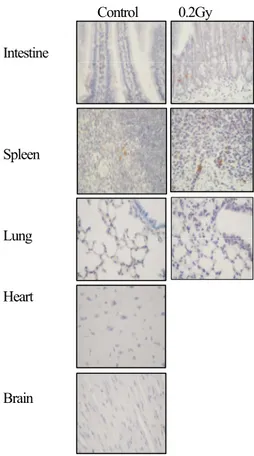Organ Specific Gene Expressions by Low Dose Radiation in C57BL/6 Mice
Woo-Jung Lee1, Hae-June Lee1, Sung Hee Hong2, Sangwoo Bae1, Su-Jae Lee3 and Yun-Sil Lee1,* 1Laboratory of Radiation Effect, 2Laboratory of Tumor Physiology and 3Laboratory of Radiation ExperimentalTherapeutics, Korea Institute of Radiological and Medical Sciences
1. Introduction
Cellular and tissue sensitivity against ionizing radiation depends on many endogenous gene expression patterns. It is well known that various stimuli such as ionizing radiation produce genetic alteration and an important factor seems to be whether the cell dies, repair all the damage, undergoes defective repair or responds in a way which leads to transformation. Variations in the radiation response in healthy people and human tissue and cells have also been described and are important in determining the potentially harmful effects of environmental, accidental, or therapeutic radiation exposure. The nature of these modifiers of the response to ionizing radiation is largely unknown. In vitro studies can not reveal the complexity of tissue response, where different cell types at different stages of differentiation/activation show markedly different responses to radiation damage .In this study, we analyzed the genes which have previously been reported to be overexpressed in human peripheral blood lymphocytes, in brain, heart, spleen, intestine, and lung which have been shown to have different intrinsic radiosensitivity, especially after low dose radiation exposure (0.2Gy), and examined the correlation between gene expression patterns and organ sensitivity and attempted to identify genes which are possibly responsible for radiation sensitivity.
2. Results
Present results suggested that organ specific gene expressions by low dose radiation can be used as markers for radiosensitivity detection in brain and heart (radioresistant organs), lung (moderately radiosensitive organ), and intestine and spleen (radiosensitive organs). We selected 5 organs, including intestine, spleen, lung, heart and brain, which showed different radiosensitivities to 0.2Gy radiation exposure, when the induction of apoptosis was detected using TUNEL assay. Because we hoped to select molecular markers for governing radiosensitivity, we applied semiquantitative RT-PCR method against 23 genes that were recently identified by cDNA microarray analysis to be overexpressed in peripheral blood lymphocytes after 1Gy
radiation. Twenty three genes includes diverse functions such as antioxidation system, cell surface marker, chaperone function, and cell cycle regulation etc. Genes of neogenine, APO-1, nuclease sensitive element binding protein-1, syntaxin, cyclin G1, hNOP56, paraoxonase, and glutathione peroxidase in all organs were expressed in response to 0.2Gy radiation, detected until 3 days after radiation, suggesting that these genes might be candidate markers for radiation exposure regardless of organ radiosensitivity. Genes such as PCNA, HSP70, and transducin beta like protein 1 were expressed in brain, heart, lung and spleen in response to radiation, but not in intestine. Sialyltransferase was expressed only in intestine and spleen that are the most radiosensitive, therefore, this gene can be a marker for radiosensitive marker. Protein tyrosine kinase and platelet membrane glycoprotein lib in lung and spleen responded by radiation, and these genes in intestine were rapidly degraded at the 3rd day after radiation, also suggesting possible candidacy for radiosensitive markers. Since B crystalline and Cu/ZnSOD were expressed only in spleen and these genes were also rapidly degraded in intestine, they might also be potential markers for radiosensitivity.
3. Conclusion
Present data suggested that neogenine, APO-1, nuclease sensitive element binding protein-1, syntaxin, cyclin G1, hNOP56, paraoxonase, and glutathione peroxidase genes which was overexpressed in PBL after radiation were all expressed in 5 organs by 0.2Gy radiation and candidate markers for radiation exposure regardless of tissue types, regardless of their functions and sialyltransferase might be a good candidate for detection of radiation exposure to the sensitive organs such as intestine and spleen.
4. References
1. Ullrich RL, Bowles MD, Satterfiled LC, Davis CM. Strain dependent susceptibility background on mammary tumorigenesis in p53 deficient mice. Cancer Res 2001;61: 6577-6582.
Transactions of the Korean Nuclear Society Autumn Meeting Busan, Korea, October 27-28, 2005
2. Watson GE, Lorimore SA, Clutton SM, Kadhim MA, Wright EG.. Genetic factors influencing alpha-particle induced chromosomal instability. Int J Radiat Biol 1996;71: 535-355.
3. Kang CM, Park KP, Song JE, Jeoung EI, Cho CK, Kim TH, Bae S, Lee SJ, Lee YS. Possible biomarkers for ionizing radiation exposure in human peripheral blood lymphocytes.
Radiat Res 2003;159: 312-319. Control 0.2Gy Intestine Spleen Lung Heart Brain
Fig 1. Tissue specific induction of apoptosis
After 1 and 3 days of 0.2Gy radiation, intestine, spleen, lung, brain, and heart tissues were removed from female C57BL6 mice, and tissues were embedded and cut into 5 mm thick sections. TUNEL staining with ApopTag plus peroxidase kit was used .The apoptotic nuclei are stained brown. Three mice were used, and similar pattern was observed.
Acknowledgements
This study was supported by Korea Institute of Science &Technology Evaluation and Planning and Ministry of Science & Technology (MOST), Korean government, through its National Nuclear Technology Program
